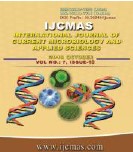


 National Academy of Agricultural Sciences (NAAS)
National Academy of Agricultural Sciences (NAAS)

|
PRINT ISSN : 2319-7692
Online ISSN : 2319-7706 Issues : 12 per year Publisher : Excellent Publishers Email : editorijcmas@gmail.com / submit@ijcmas.com Editor-in-chief: Dr.M.Prakash Index Copernicus ICV 2018: 95.39 NAAS RATING 2020: 5.38 |
The Asiatic honey bee, Apis cerana indica harvests pollen and nectar from the flowers and helps in pollination process. Bee pasturage in the location is essential for better management of the hives and improving the yield. Floral diversity in the Madurai region was studied which revealed that the flora was belonging to 76 families. Among them family Fabaceae contributed a maximum of 31 species (12.25%) followed by Asteraceae 6.72% with 17 flora, Caesalpiniaceae (5.53%) and Cucurbitaceae (4.74%). The grouping of bee pasturage revealed that 41 were nectar yielders, 30 were pollen yielders and 182 of both nectar and pollen yielders.
 |
 |
 |
 |
 |